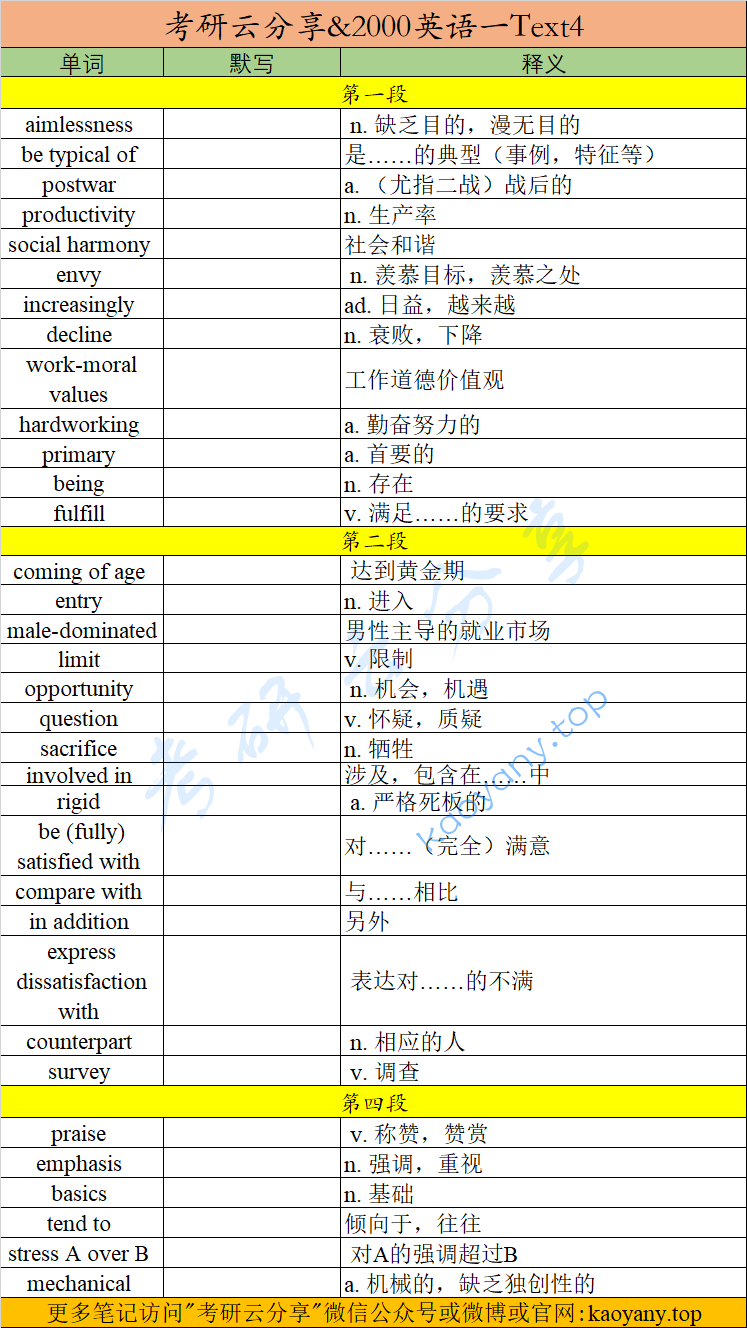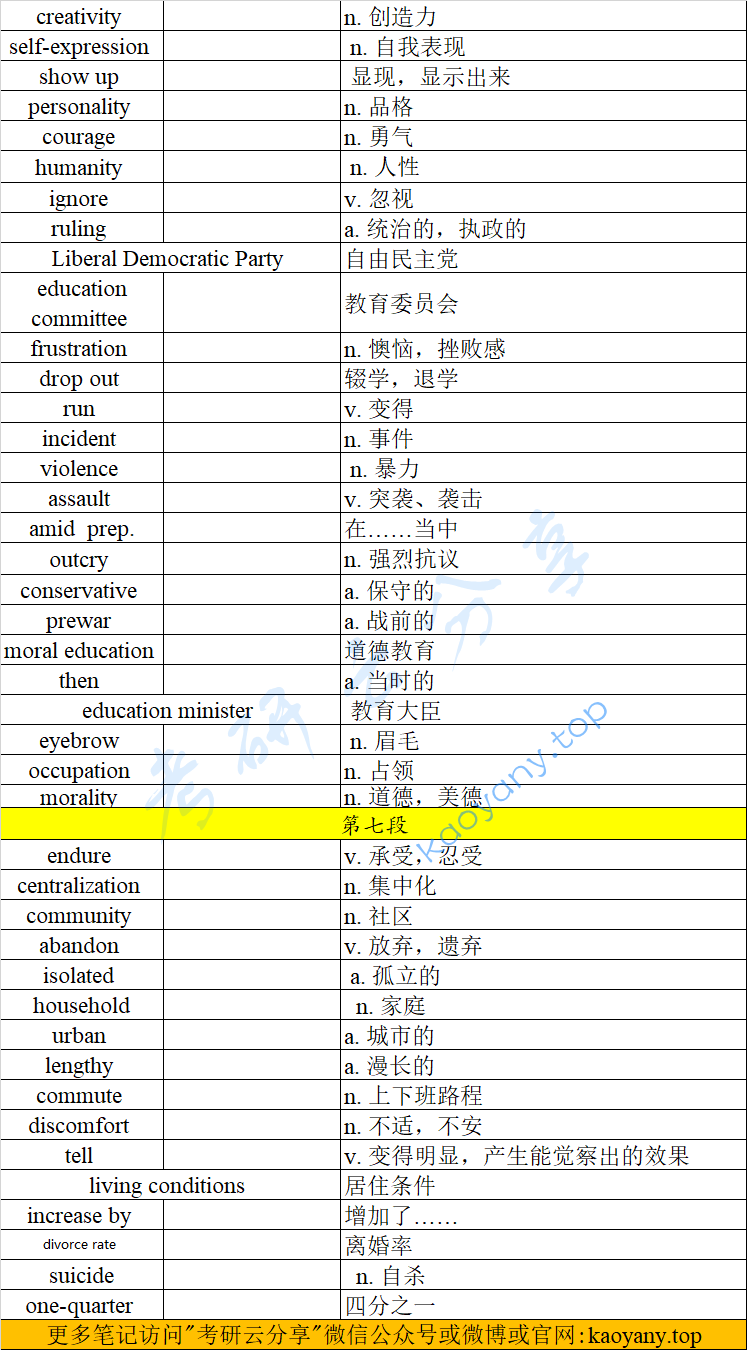第一段
①Aimlessness has hardly been typical of the postwar Japan whose productivity and social harmony are the envy of the United States and Europe.②But increasingly the Japanese are seeing a decline of the traditional work-moral values.③Ten years ago young people were hardworking and saw their jobs as their primary reason for being, but now Japan has largely fulfilled its economic needs, and young people don’t know where they should go next.
单词&词组
aimlessness n. 缺乏目的,漫无目的
be typical of 是……的典型(事例,特征等)
postwar a. (尤指二战)战后的
productivity n. 生产率
social harmony 社会和谐
envy n. 羡慕目标,羡慕之处
increasingly ad. 日益,越来越
decline n. 衰败,下降
work-moral values 工作道德价值观
hardworking a. 勤奋努力的
primary a. 首要的
being n. 存在
fulfill v. 满足……的要求
本段翻译
毫无目标几乎从来都不是战后日本的典型特征,其生产率与社会和谐度令美国和欧洲称羡。然而,目前日本人正在经历传统工作道德价值观的日益衰败。十年前,日本年轻人工作勤奋,将工作视为存在的首要理由,但现在日本的经济需求已大体得到了满足,年轻人却不知道接下来应何去何从。
第二段
①The coming of age of the postwar baby boom and an entry of women into the male-dominated job market have limited the opportunities of teen-agers who are already questioning the heavy personal sacrifices involved in climbing Japan’s rigid social ladder to good schools and jobs.②In a recent survey, it was found that only 24.5 percent of Japanese students were fully satisfied with school life, compared with 67.2 percent of students in the United States.③In addition, far more Japanese workers expressed dissatisfaction with their jobs than did their counterparts in the 10 other countries surveyed.
单词&词组
coming of age 达到黄金期
entry n. 进入
male-dominated job market 男性主导的就业市场
limit v. 限制
opportunity n. 机会,机遇
question v. 怀疑,质疑
sacrifice n. 牺牲
involved in 涉及,包含在……中
rigid a. 严格死板的
be (fully) satisfied with 对……(完全)满意
compare with 与……相比
in addition 另外
express dissatisfaction with 表达对……的不满
counterpart n. 相应的人
survey v. 调查
本段翻译
“战后婴儿潮一代进入职业黄金期”以及“女性进入男性主导的就业市场”都限制了青少年的发展机遇,而他们早已开始质疑,为攀登日本等级森严的、通往好学校、好工作的社会阶梯所付出的沉重的个人牺牲(是否值得)。一项近期调查显示,与67.2%的美国学生相比,只有24.5%的日本学生对学校生活完全满意。此外,与被调查的其他10个国家的工人相比,对个人工作表示不满的日本工人的数量要多出许多。
第三段
①While often praised by foreigners for its emphasis on the basics, Japanese education tends to stress test taking and mechanical learning over creativity and self-expression.②“Those things that do not show up in the test scores—personality, ability, courage or humanity—are completely ignored,” says Toshiki Kaifu, chairman of the ruling Liberal Democratic Party’s education committee.③“Frustration against this kind of thing leads kids to drop out and run wild.”④Last year Japan experienced 2,125 incidents of school violence, including 929 assaults on teachers.⑤Amid the outcry, many conservative leaders are seeking a return to the prewar emphasis on moral education.⑥Last year Mitsuo Setoyama, who was then education minister, raised eyebrows when he argued that liberal reforms introduced by the American occupation authorities after World War II had weakened the “Japanese morality of respect for parents.”
单词&词组
praise v. 称赞,赞赏
emphasis n. 强调,重视
basics n. 基础
tend to 倾向于,往往
stress A over B 对A的强调超过B
mechanical a. 机械的,缺乏独创性的
creativity n. 创造力
self-expression n. 自我表现
show up 显现,显示出来
personality n. 品格
courage n. 勇气
humanity n. 人性
ignore v. 忽视
ruling a. 统治的,执政的
Liberal Democratic Party 自由民主党
education committee 教育委员会
frustration n. 懊恼,挫败感
drop out 辍学,退学
run v. 变得
incident n. 事件
violence n. 暴力
assault v. 突袭、袭击
amid prep. 在……当中
outcry n. 强烈抗议
conservative a. 保守的
prewar a. 战前的
moral education 道德教育
then a. 当时的
education minister 教育大臣
eyebrow n. 眉毛
occupation n. 占领
morality n. 道德,美德
本段翻译
虽然因重视基础教育而时常受到外国人的赞扬,但日本教育往往重视“应试和机械学习”胜过“创造性和自我表现”。“考分反映不出的那些东西——品格、能力、勇气和仁爱之心——完全被忽视,”执政的自民党教育委员会主席Toshiki Kai fu说, 这种情况产生的挫败感致使孩子们辍学、无法无天。”去年日本发生了2,125起校园暴力事件,其中包括929起攻击教师事件。在一片抗议声中,许多保守的领导人开始寻求回归战前对道德教育的重视。去年, 时任教育大臣Mitsuo Set oyama就表达了不满, 认为第二次世界大战后由美国占领当局引进的自由改革削弱了“日本人尊敬父母的道德观”。
第四段
①But that may have more to do with Japanese life-styles.②“In Japan,” says educator Yoko Muro, “it’s never a question of whether you enjoy your job and your life, but only how much you can endure.”③With economic growth has come centralization;fully 76 percent of Japan’s 119 million citizens live in cities where community and the extended family have been abandoned in favor of isolated, two-generation households.④Urban Japanese have long endured lengthy commutes (travels to and from work) and crowded living conditions, but as the old group and family values weaken, the discomfort is beginning to tell.⑤In the past decade, the Japanese divorce rate, while still well below that of the United States, has increased by more than 50 percent, and suicides have increased by nearly one-quarter.
单词&词组
endure v. 承受,忍受
centralization n. 集中化
community n. 社区
abandon v. 放弃,遗弃
isolated a. 孤立的
household n. 家庭
urban a. 城市的
lengthy a. 漫长的
commute n. 上下班路程
discomfort n. 不适,不安
tell v. 变得明显,产生能觉察出的效果
living conditions 居住条件
increase by 增加了……
divorce rate 离婚率
suicide n. 自杀
one-quarter 四分之一
本段翻译
但那也许与日本人的生活方式的关系更大。教育家Yo koMuro说:“在日本, 问题从来都不是‘你是否喜欢自己的工作和生活’,而只是‘你能忍受多少’。”随着经济的发展,集中化接踵而至。日本一亿一千九百万居民中,足足有76%的人生活在城市,这里社区生活和几代同堂的大家庭已成为过去,取而代之的是单门独户的两人之家。虽然城市里的日本人长期忍受着漫长的(上下班往返)路程和拥挤不堪的居住条件,但是随着传统的集体和家庭价值观念的削弱,人们的不适感开始突显。过去10年中,日本的离婚率尽管依然远低于美国,却也已经上升了一半还多,而自杀率则上升了近1/4。
五道题
23. In the Westerners’ eyes, the postwar Japan was .
A:under aimless development
B:a positive example
C:a rival to the West
D:on the decline
24. According to the author, what may chiefly be responsible for the moral decline of Japanese society?
A:Women’s participation in social activities is limited.
B:More workers are dissatisfied with their jobs.
C:Excessive emphasis has been placed on the basics.
D:The life-style has been influenced by Western values.
25. Which of the following is true according to the author?
A:Japanese education is praised for helping the young climb the social ladder.
B:Japanese education is characterized by mechanical learning as well as creativity.
C:More stress should be placed on the cultivation of creativity.
D:Dropping out leads to frustration against test taking.
26. The change in Japanese life-style is revealed in the fact that .
A:the young are less tolerant of discomforts in life
B:the divorce rate in Japan exceeds that in the U.S.
C:the Japanese endure more than ever before
D:the Japanese appreciate their present life
参考答案
BDCA
答案解析
23、根据题干关键词postwar定位到第一段①句。该句指出, 战后日本的生产力水平与社会和谐程度为美国和欧洲所称羡,可见在西方人眼中,日本是一个成功的范例,[B]项正确。
24、文章第二至四段分析了日本道德水平下降的多种原因。第四段①句“(日本社会中道德观的弱化) 更多地与生活方式有关(But that may have more to do with Japanese life-styles) ”表明作者认为“生活方式(的改变)”实为最主要的原因;该段②至⑤句具体说明生活方式改变如何造成道德水平的下降,其中③④句表明经济发展促使人们逐渐抛弃大家庭,而建立起独门独户的小家庭,集体和大家族观念逐渐淡去(as the old group and family values weaken) , 因此[D] 选项正确。
25、根据四个选项中的关键词Japanese education、mechanical learning、stress、creativity、dropping out等可以定位至第三段。该段指出了日本当前的教育弊端:①句先总述其问题“重视应试和机械性学习胜过创造力和自我表达的培养”,接着②③句引教育人士之言说明这种情况造成严重后果:孩子们辍学,变得难以管教,校园暴力频发。由此可知,作者认为教育应加强对学生的创造力和自我表达能力的培养,所以[C]项正确。
26、根据题干关键词life-style定位到第四段。该段②句指出, 日本人的生活最多体现在“忍受力的大小”。④句指出,随着生活方式的改变,新一代的日本人不像从前那样愿意忍受生活中的不适。⑤句提到的离婚率和自杀率的上升就是不堪忍受的表现。可见,[A]是日本生活方式改变的表现


- 单词 词组
- 本段翻译
- 单词 词组
- 本段翻译
- 单词 词组
- 本段翻译
- 单词 词组
- 本段翻译
- 参考答案
- 答案解析
